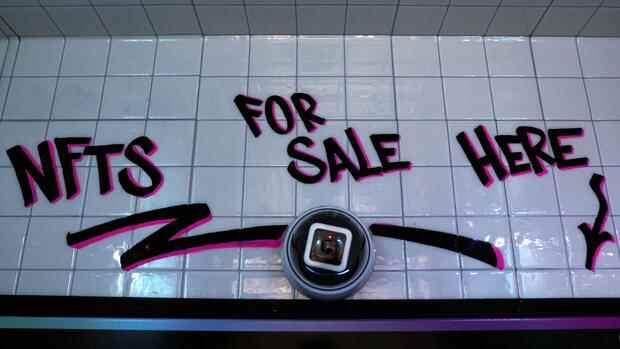In Manhattan, this lettering directs potential customers to a vending machine for non-fungible tokens. The operator is the platform Neon.
(Photo: Reuters)
Frankfurt The good mood on the market for NFTs is over for now. Trading volume for digital art and status symbols depicted on the blockchain has plummeted 55 percent from its most recent high in early March, according to figures from analytics firm NonFungible.
Apparently, the war in Ukraine and concerns about the consequences are making investors cautious. NFTs stands for Non-Fungible Tokens, which have seen a lot of hype over the past year. At the end of 2021, the market was worth $41 billion, according to Chainalysis data.
Investors spent millions of dollars on popular projects like CryptoPunks and Bored Apes. Companies like Adidas and Nike also jumped on the trend, especially with digital fashion and collectibles in mind.
Industry experts are now talking about a bear market for NFTs. An index of large NFT projects from the provider Bitwise has lost around 15 percent in value in the past four weeks.
Top jobs of the day
Find the best jobs now and
be notified by email.
Even before the Russian invasion of Ukraine, the mood on the NFT market was tense at times. This was due to increased reports of NFTs being used for money laundering, insider trading, market manipulation or other illegal activities.
The Opensea platform was recently the victim of a hacker attack.
(Photo: Reuters)
Chainalysis, which also works with state agencies, found “small but visible” money laundering activity in NFTs, according to a report. In the third quarter of 2021, funds sent from illicit addresses to NFT marketplaces jumped “significantly.”
An address in this context is a kind of account number to which cryptocurrencies or NFTs can be sent. The Chainalysis experts wrote in the report that the total value of funds sent to NFT platforms from addresses linked to illegal activities surpassed one million dollars worth of cryptocurrencies for the first time during this period.
In the fourth quarter, the amount increased further to $1.4 million, with a significant portion of the total coming from addresses associated with sanctions for the first time. Kim Grauer, who heads the analysis house’s research arm, explains how the experts work: “We can analyze money laundering by looking at the origin of the funds coming into NFT platforms. And if they come from a hack, we can see that malicious actors have interacted with NFT platforms.”
Caroline Malcom, who heads the International Policy department, also emphasizes that this work is still in its infancy. “As our data shows, growth in the NFT market has exploded over the last 12 to 18 months. So we are only in the early stages of implementation in terms of prosecuting NFT-related crimes,” she explains. The NFT market could therefore have to contend with even greater problems in the future than previously known.
Other experts, however, are more relaxed. According to Patrick Hansen, crypto expert and head of the “Strategy & Growth” department at Berlin-based fintech Unstoppable Finance, “there is actually no question of a general end to the trend” for NFTs.
The numbers in terms of trading volume or sellers and users would be falling compared to January. But initiatives by large companies such as Instagram, Spotify and Coinbase have potential to further drive the market.
The crypto exchange Coinbase is working on its own NFT marketplace. The music streaming service Spotify apparently also wants to offer artists the opportunity to link NFTs to their works, as the corresponding job advertisements indicate. The Meta subsidiary Instagram also wants to offer its users the opportunity to create and sell NFTs in the future.
More: Putting a damper on the crypto art gold rush
